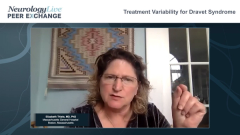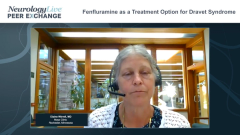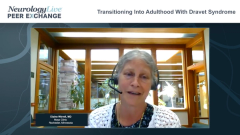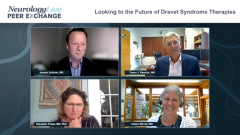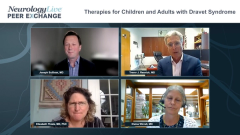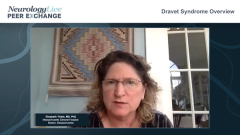
Impact of Dravet Syndrome on the Caregiver and Family
The panel discusses the impact on the family, siblings, or caregivers of patients with Dravet syndrome.
Episodes in this series

Joseph Sullivan, MD: We’ve talked a lot about seizures and quality of life. Let’s segue into the impact this has on the family and the caregiver. We’re all epileptologists. In most situations, when I try to talk to my patient, who is a child, I feel like I have 2 or 3 patients with each visit because the caregivers are needing just as much of our support as the child themselves. Elizabeth, could you give us a summary of what you feel in your experience is the caregiver burden for these families? It’s one form of a catastrophic epilepsy that probably shares a lot of similarities to other epilepsies. What’s your experience with this patient population?
Elizabeth Thiele, MD, PhD: Joe, what you said is absolutely right. Pediatric epileptologists don’t just treat seizures; we take care of children and families. Most of my practice, as all of ours, consists of treating children with refractory epilepsy. As you said, for the families of all those children, there’s incredible pressure, tension, and emotional weight for siblings, parents, etc. Maybe the families of patients with Dravet syndrome are even harder hit, with the frequency of the seizures, the triggers, the anxiety of what’s going to happen at night, and the increased risk of SUDEP [Sudden Unexpected Death in Epilepsy]. Studies have looked at the impact on parents needing to quit a job to stay home and take care of the child, the impact on the siblings, and the incidence of depression and anxiety in siblings. It’s profound.
When we approach the treatment of a child with Dravet syndrome, we also approach the management, understanding, and support of the families. I have one Dravet family with 4 children under the age of 12, including a child with Dravet with very frequent seizures and both parents trying to work. Especially during the COVID-19 pandemic, that was a real nightmare. I have another child with Dravet who has bright light-triggered seizures in a big way, so much so that even going outside into natural daylight will often trigger seizures. That’s a family that then basically stays inside and doesn’t go out. I find that these families really constrict their worlds to protect their child, minimize seizures, and minimize the trauma of having Dravet on their child. The impact on the whole family is really profound.
Joseph Sullivan, MD: Absolutely. I’m glad you brought up siblings, because not only are families dealing with Dravet, always on high alert with bags packed—a seizure happens and it’s off to the hospital—siblings are left feeling a little neglected. These parents are doing the best they can, but the siblings do deserve some attention there.
This has gone so far. In my practice, I’ve had a very generous family. The mom was a licensed therapist, an LCSW [licensed clinical social worker], and put together a deck of cards for life support for families living with epilepsy. It has very nuts-and-bolts information. My favorite one says, “What do you do when you get angry or frustrated with your neurologist?” When you flip over the card, it walks you through a couple of things that we’ve been talking about here. It’s a testament to trying to at least acknowledge the stress these families are under.
We touched upon it in our consensus guidelines, too. We tried to get a little beyond seizures to have some guidelines about some of the other issues that impact these patients, including behavior, sleep, and some of the motor problems. In a perfect world, it would be a multidisciplinary approach. Trevor, in a perfect world, if we were not resource-limited in our hospitals, how important is it to have this approach to caring for these patients?
Trevor J. Resnick, MD: It really is a multidisciplinary approach. As we mentioned earlier, depending on the child, each aspect of developmental regression or behavioral difficulty will be different. That’s why, if you have your group of therapists—including a behavioral therapist, physical therapist, occupational therapist—depending on the individual child, they may need to spend more time with one child as opposed to the other child in a specific area.
I have one child—he’s not a child anymore, he’s 25—with Dravet, who has the issue with the crouched gait. The apraxic difficulty has been such an issue for him. It’s almost like he has a visual perceptual problem when he walks. He’s planning for where he has to sit down, and how he has to turn around and sit down. He can’t do it. For him, that motoric disability is his biggest issue. It may not be the biggest issue for some of the other kids whose behavioral issues are greater, either regressive or aggressive behavior.
You have to have this team together. Depending upon the individual patient, 1 or 2 members of that team will be spending most of their time with the child. Elaine mentioned earlier the importance of having the Dravet Syndrome Foundation available for the parents to be able to not necessarily only listen to their own neurologist, but hear what everybody else is talking about. The fortunate thing with the foundation is that they are grounded in so much fact that you’re not going to hear the outrageous theories you sometimes hear in terms of what needs to be done for their child. It’s very helpful for parents to be able to be directed to a reliable place like that to get opinions and hear someone else talking.
Joseph Sullivan, MD: After all, if you think about the name, it’s a syndrome. A syndrome is a constellation of signs and symptoms that go beyond just seizures. The Dravet Syndrome Foundation tries to identify Dravet centers of excellence, which are anchored in having at least some of these multidisciplinary providers. In a world of unlimited resources, we would have all of them. But as a Dravet community, we certainly feel that you at least need to have access to the ketogenic diet, physical therapists, and occupational therapists.
Getting back to how we started this conversation, the value of making a syndrome diagnosis is paramount. I know there are some groups around the world that are starting to look at these gait problems so we can better understand why they’re occurring and if there’s something we can do about it. We definitely know that orthopedic surgery is not the answer for it, but are there things like special gait training that could prevent this crouched gait and lead to improved mobility of these patients?
Thank you for watching this NeurologyLive® Peer Exchange. If you enjoyed the content, please subscribe to our e-newsletters to receive upcoming Peer Exchanges and other great content right in your inbox. Thank you.
Transcript Edited for Clarity
Newsletter
Keep your finger on the pulse of neurology—subscribe to NeurologyLive for expert interviews, new data, and breakthrough treatment updates.


